Movies for the Rest of Us with Bill Newcott: 5 Movies You Should Have Seen in 2017
Join our movie review video podcast, Movies for the Rest of Us with Bill Newcott. This week, Bill reviews excellent movies you might have overlooked in 2017.
Most Popular Contemporary Fiction of 2017
The Saturday Evening Post continues to discover and publish the works of new, talented authors. Take a look at our most read contemporary fiction short stories.
1. “Crack” by Myles McDonough
Winner of the 2016 Great American Fiction Contest: At Highland Hospital, Zelda Fitzgerald found refuge from the world — but not from Scott. Read more »
2. “Over-Town” by Terry Sanville
Doris might never have come to the island if it weren’t for Jack. But with her husband gone, will she stay on Catalina or return to the mainland life she left behind? Read more »
3. “Just for Me” by K. Anne Smith
K. Anne Smith explores the value of objects after the loss of a loved one. Read more »
4. “The Absence of Sound” by N. West Moss
A quiet man who works at the New York Public Library contemplates the space created by absences, both recent and in the past. Read more »
5. “Man of Letters” by Robert McGuill
A succession of unread letters forces a father to examine the strained relationship he has with his son. Read more »
6. “Recluse” by Chet Martin
Years of caring for a brother who won’t leave his room has driven Hattie to desperation. With hopes of urging him outside, she enlists the help of a female suitor, a ghost, and the literary genius of Edgar Allan Poe. Read more »
7. “Pigeons” by Sophia Veltfort
Despite growing doubts over her long-distance relationship, a young woman moves in with her boyfriend’s mother after her New York City sublet falls through. Read more »
8. “Getting Home” by Mark Fabiano
How could Michael explain to his son that when you do nothing, bad things can happen, but also sometimes, even when you stand up and do all you can, things still can go bad? Read more »
9. “Long Past Time” by James Reed
With the news of his ex-mother-in-law’s death, a man faces disturbing questions about his failed marriage to a woman who had always seemed a stranger.
Read more »
10. “A Colossal Mistake” by Frank Morelli
“In a field planted heavily with beefcakes, the rotten tomato is easy to spot.”
Read more »
News of the Week: Goodbyes to 2017, Resolutions for 2018, and Lost Letters from 1944
A List of Lists
According to a scientific poll that I just made up, 99.4 percent of all people love lists. We love thinking about and debating the best this and the best that of all time, or the worst this and that, or the most overrated and underrated. And the end of a year makes us happy because that’s when we get an avalanche of lists, lists, lists.
NPR has a great interactive list of the best books of the year, and the staff of The Atlantic picks their favorite books too. The magazine also lists their 50 favorite podcasts of 2017. There are approximately 9 million best-of TV lists, including these from David Bianculli at NPR, The New Yorker’s Emily Nussbaum, and Vulture‘s Matt Zoller Seitz. The New York Times has its list of the best movies, and here’s USA Today’s list.
Looking for “worst” lists because they can be the most fun to read? The A.V. Club picks the 20 worst films of the year, Time has the 10 worst songs of the year, and TVLine has their picks for the 10 worst TV shows. Matt Zoller Seitz isn’t going to be happy that the show he picked as the very best of 2017 is one of the worst on TVLine‘s list.
We have some lists here at the Post too, including our most popular articles of the year, the best cartoons, and our most popular cover collections of 2017.
My favorite Post cover of the year is on the November/December issue, and it’s actually from 1957.
In 2018, I Will …
There’s only one thing more annoying than people who tell you what their New Year’s resolutions are, and that’s the people who tell you that they don’t make New Year’s resolutions. Apparently these people live golden, flawless lives and don’t need to make any changes.
I get it. You don’t want to make resolutions because it’s a lot of pressure, it’s too formal, too cliché, and besides, “everybody does it.” But isn’t it natural to take stock of your life at the end of a year, to look back at what has happened the past 12 months and think of what the new year holds? It’s the end of December and you’re organizing things for January, planning, hoping. Even if you’re not consciously thinking “these are my resolutions” and writing them down, you’re still thinking of making changes in the new year.
What do you think is the most popular resolution for 2018? You might think it’s to lose weight, save money, or exercise more (hey, those have been my top three every year since 1997!), but it’s actually something else, according to this Marist poll.
If you want to know how you can stick to your resolutions, Fast Company has some tips. Hint: It actually does help if you write them down.
The X-Files Is Back (Again)
The X-Files reboot from last year was met with a mixture of excitement and (ultimately) disappointment. A couple of the episodes were good, but I think overall, fans wanted something a little bit more or even different. Judging by this trailer for the new season that starts January 3 on Fox, the show knows that. Looks pretty good!
RIP Rose Marie, Dick Enberg, and Dominic Frontiere
Rose Marie was a star for 90 years (!), since she was a little girl, singing and dancing and acting on stage and in movies as “Baby Rose Marie,” but she’s probably best known to TV fans for her role as writer Sally Rogers on The Dick Van Dyke Show. She had a critically-acclaimed documentary about her life released this year titled Wait for Your Laugh. She died yesterday at the age of 94.
Dick Enberg was a legendary sportscaster who covered 28 Wimbledons, 10 Super Bowls, Major League Baseball games, and endless college football games. He died last week at the age of 82.
Dominic Frontiere composed many themes for classic TV shows, including The Outer Limits, The Rat Patrol, The Flying Nun, The Invaders, That Girl, and Vega$, as well as many movie themes. He died last Thursday at the age of 86.
The Best and the Worst
Best: My favorite stories of the week both involve letters from World War II.
In Greenfield, Massachusetts, Francesca Passiglia found a love letter inside the walls of her home while it was undergoing renovations. It was dated April 19, 1944, from a man named Walter to a woman named Betty. Passiglia asked the Greenfield Police Department to help her solve the mystery of Walter and Betty and the department (of course) turned to Facebook. They found out who Betty was, but they’re still looking for Walter. It seems Betty dated two Walters in the ’40s.
And CBS News Sunday Morning had a great segment on Donna Reed and the letters that overseas soldiers wrote to her during World War II. After Reed died in 1986, her daughter found them. There were 350 in all and Reed had saved them for 40 years:
Worst: The worst (and oddest) news of the week? Nestl\0xE9 has announced they’re getting out of the chocolate business! That’s like McDonald’s announcing they’re not going to sell cheeseburgers anymore. The company has decided to concentrate on their other products, including bottled water, coffee, cereal, and frozen foods.
This Week in History
Vincent Van Gogh Cuts Off His Ear for Some Reason (December 23, 1888)
Why did the artist do that? Turns out, nobody really knows the answer. He could have gone crazy, been mad at a rival, or maybe he simply didn’t like having two ears. A more recent theory claims that Paul Gauguin (yes, the artist) lopped it off with a sword during an argument, and that van Gogh claimed to have done it himself to protect his friend. With friends like that …
Rod Serling Born (December 25, 1924)
Did you know that there’s a new Twilight Zone coming next year? You’re going to have to pay for it, though, as it will join Star Trek Discovery on CBS’s All Access streaming service.
This Week in Saturday Evening Post History: More Snow? (December 29, 1951)
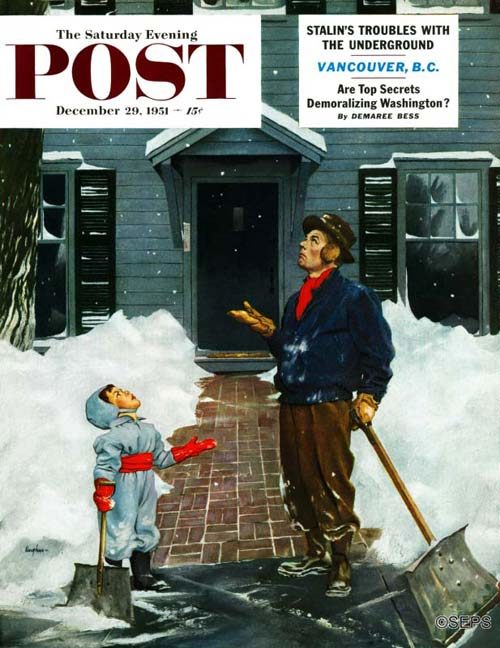
George Hughes
December 29, 1951
We’ve all been there — maybe you are there this week — in that moment when we finally finish shoveling the walkway and we notice it has started to snow once again and we’re going to have to shovel again in a few hours. This George Hughes cover captures that moment.
A Lot of People Are Saying This Right Now
Please, no more leftovers. pic.twitter.com/iXPk2K81Lm
— PEANUTS (@Snoopy) November 25, 2017
National Champagne Day
It makes sense that December 31, New Year’s Eve, is also National Champagne Day, since it’s probably the one day of the year that most people drink Champagne. In many countries, you can’t use the word Champagne on bottles unless the grapes were produced in the Champagne region of France, though there are some exceptions.
Esquire has a list of 11 great Champagne cocktail recipes, including the French 75, the Black Velvet, the Atomic Champagne Cocktail, and Ernest Hemingway’s Death in the Afternoon.
If you do open a bottle on New Year’s Eve while watching the ball drop in Times Square, please make sure you point it away from your guests’ faces. That could just ruin the whole night.
Happy New Year!
Next Week’s Holidays and Events
National Hangover Day (January 1)
If you celebrated National Champagne Day just a little too much, here are some remedies for the way you’re feeling, including eating a big breakfast, getting plenty of sleep, and staying hydrated.
The top suggestion on that list is “limit your alcohol intake,” but if that were the case, you wouldn’t be reading that list.
College Bowl Games (January 1)
If you haven’t been watching college football the past couple of weeks, you’ve missed the R+L Carriers New Orleans Bowl, the AutoNation Cure Bowl, the Cheribundi Tart Cherry Boca Raton Bowl, the Famous Idaho Potato Bowl, and the Starbucks Listerine National Bowl. Okay, I made up that last one, but the others are real.
Here’s a list of the games you can watch on New Year’s Day.
Open Season at the Café Rumba

I freeze in the doorway of Café Rumba. I’m too old for salsa, I have to be. My hips haven’t swayed for a long time, unless you count pushing open the door to the doctor’s office when my hands were busy with Mother’s wheelchair, and the last time I checked, such motion does not inspire unbridled passion in the opposite sex. I put on my favorite black pumps tonight, the ones with just a hint of sheen, but now I fear they are too formal for this dance-and-let-dance affair. I also have on my favorite crushed velvet dress, perfect for a winter wedding but, again, perhaps ill-advised for a steamy milonga. The dress shimmers in low light — that’s why I like it so much — though there is a tipping point that makes my pear shape look more like runny plum. Please God, don’t let the room get so hot that I regret my choice. Salsa, I’m told, generates a lot of heat, thermal and otherwise.
Mother hated this dress on me. And if she were still here, she would have let loose plenty of opinions about my coming here tonight, too. “There’s no call to be so gussied up on a Wednesday, Nancy, even for a dance,” I can hear her wheezing from her station at the card table in the living room. “It’s not becoming on a woman your age. Do you want those Latin men to mistake you for a streetwalker?”
Only Mother would have believed any outfit selection of mine could lure men in our mild-mannered town into a pay-by-the-hour motel. We don’t have those anyway in Nordeast; we’d have to go to the Holiday Inn by Route 494 instead, and that would eat up a working girl’s whole commission. What I would have had more trouble explaining was that it didn’t matter what I wore — the point was that I was going out. Out of the house. Alone.
Beyond the bouncer in the double doorway, I see the salsa diehards warming up. Their very practice swivels look sultry. One woman in the corner — who, come to think of it, looks older than me — is putting on her shoes. She is dressed in black from head to toe, hair dyed to match, and she’s not so much sitting in the folding chair as draping herself upon it. She reaches down her taut calf and, with a languid flourish, pulls the ankle strap tight. The effect stuns me. There’s more sex in that movement than I’ve experienced in total over my lifetime, and that includes my 21-year marriage to Darren, with whom I was quite satisfied for 14 of those years and miserable for the 7 leading up to the divorce, and also that one fling in college that involved an inadvisable amount of wine but still makes me blush whenever I think about it.
Despite the cold, I start to drip sweat.
The dancers look nowhere near as tame as the clip art figures on the flyer I first saw on the Curves community board last Tuesday and then again in the teachers’ lounge on Thursday. The simple 8½-x-11 sheet detailed the free lessons-cum-open dance sessions happening weekly at Café Rumba, “the hottest ticket in town.” Toner streaks cut through the early-’90s image of two tango dancers frozen in a swoon. What caught my eye both times, besides the incongruity of tango dancers on a salsa advertisement, was the promise in Comic Sans at the bottom of the sheet: “Find your passion … for passion!”
I mulled over that phrase all weekend. Were the flyer creators assuming a base level of passion in everyone? Could passion be taught? Unleashed? Did hopeless cases exist? Was I one of them? I relayed this train of thought to Cynthia on our Monday-morning walk, and she rolled her eyes at me. “Nancy, would it kill you to go and — I don’t know — try it? No one’s around to stop you anymore. You want it, you do it. And for god’s sake, please don’t overthink anything written in Comic Sans. Ever.”
Cynthia was right, of course. She usually is. Which is why I rushed my dress to the dry cleaners and left school right on time today. Oh, and took a small nip of Irish Mist from the liquor cabinet. Anything to keep me from overthinking.
“Ma’am?” The bouncer raises his eyebrows at me and tilts his head at the growing line of hoofers behind me ready to escape the bleak midwinter. Most of them are hopping from one cold foot to the other, careful to avoid the dirty slush along the sidewalk outside the club.
“So sorry, here you are.” I hand him my license and he dutifully inspects it — a run-of-the-mill procedure for which I am suddenly, wildly grateful because it lets me pretend for a moment that I don’t look every day of my 51 years, with extra wear thrown in after Mother’s two strokes. He nods and hands it back to me. Over his shoulder, I see that Sexy Shoe has taken to the floor with a much younger man. They are drooling their legs across the parquet, no music yet, simply moving with each other.
I smile at the expressionless bouncer and edge around him through the second door, already propped open, defeating its proper Midwestern purpose of blocking relentless drafts. People made bulkier by their winter coats pen me in. I ricochet off one woman barreling through the crowd who screeches over her shoulder at her huffing companion, “Stan, hurry! I see an open chair!”
Café Rumba used to be Vinelli’s Garage. Of the crowd gathered here, I am likely among the 12 percent old enough and native enough to remember that bit of trivia. Daddy used to bring me along when the Chevy came due for an oil change or the brakes started squeaking again. I’d sit on a wobbly bench near the multi-paned garage doors at the front and watch the grease monkeys at play. And I always made sure to keep my ruffled socks and starched jumper well out of range of the oil slicks, or Mother would wear out me and Daddy with another awful tirade upon our return.
Tonight, the only oil in sight is the pomade I thought went out of style in 1957 but is evidently enjoying a resurgence within the Twin Cities’ immigrant community. Whoever renovated the place — a local family, the Padins I think I saw in the paper — has whitewashed the three-car-wide interior and added a dated drop ceiling that looks as if someone first walked across the panels with an aerator. They don’t go in much for adornment. A Blessed Mother painting hangs by the doorway, and small tea lights feebly flicker on craft-store sconces against the walls. Otherwise, the whitewash runs uninterrupted. Its simplicity offsets what I’m suspecting is the chief reason for Café Rumba’s skyrocketing popularity in town: Who needs décor when you have a throbbing mass of people eager to see and be seen, to touch and be touched?

I glance behind me at the distinctive garage doors, now transformed into the front windows. The panes are already fogging up in confusion over the viscous heat within and nippy bite without. Inching my way over to where the wobbly bench used to be, I watch the entry line snaking its way down Fitzgerald Avenue. It files inside steadily — the bouncer has found his groove — and within minutes, everyone’s soggy hand-knit caps and Vikings scarves are tipping the coat racks and obscuring the chairs. I hide my purse behind one such mound. God forbid it and my car keys walk away tonight — Cynthia is away for a couple days, and I’m not sure who else I could call to come fetch me.
“Bienvenidos a la Café Rumba!” The D.J.’s smooth voice coats the din, puts coasters underneath the clacking heels, adds a bit of slick to the pompadours. The crowd pipes down imperceptibly. From my vantage point along the perimeter, I watch eye communication fly across the room. Already, potential partners are sizing each other up, filling unspoken dance cards. I furtively peek around. No one is peeking back.
“Who’s in the mood for a little …” — here the D.J. pauses for dramatic Latin effect — “…SALsa?” I’ve never heard the dance name pronounced that way before, as if someone were sighing the A to a lover in a clandestine embrace, as opposed to the sharp, nasal A I use when asking the 15-year-old Superfresh employee where the Pace brand is in the condiment aisle. The exotic pronunciation works magic on the crowd; they cheer and clap and crowd a little closer to the turntable at the far edge of the parquet, back near where the garage manager’s office used to be. Grinning, the D.J. waves his arm to the right of the room and says, “Please welcome your … instructors!”
To my surprise, Sexy Shoe and her barely legal partner move to the center of the floor, cutting through the throng like heated butter knives. People step aside for them, in awe of their cat-like ability to prowl while walking. Once in the middle, Barely Legal fixes his eyes on his partner’s face and takes her in his arms. She in turn lifts her sharp chin but lowers her lashes, combining “come hither” and “I have mace” messages to admirable effect. They strike me as locked and loaded, a phrase I hear the seventh-grade boys use in the library when they’re playing gunfight amid the stacks instead of picking out books for the week. This pair’s interpretation of the phrase, however, is the real deal; they carry danger in the curve of their backs and gunpowder in the nearness of their torsos. Despite already standing 20 feet from them, with hedgerows of bodies in between, I back away. I’m hot enough as it is — no need to push it.
The D.J. starts the music, a number full of Spanish guitar and wailing vocals. Their eyes never straying from each other, Sexy Shoe and Barely Legal carve out the dance floor with hips and heels. The appreciative crowd whoops in segments, an aural wave, whenever they sway past. The couple is now swinging around to my corner of the room, ready to begin the formal lesson. The people in front of me reflexively step back and bump me. The backs of my knees hit the folding chair. I teeter and jut an arm toward the window for support.
Someone grabs my elbow. “Whoa there. Steady now.”
The voice is deep, rounded, without the prairie-flat intonations that wallpaper my life here. I look up at my steady-er. An older gentleman, maybe 10 or so years on me, a soft kind of plump, but well-dressed enough to hold it all in. A respectable head of brown hair and full beard with trailing brushstrokes of gray at his temples and in the mustached creases around his smile. The neatnik in me wants to reach out and incorporate the silver streaks with my fingers, as if they were splashed there during an art lesson. I don’t, of course; personal space is to be respected, even at a salsa lesson.
In the same breath, we notice he still has me by the elbow. He laughs, one woof of a HA!, and says, “Let me release you before this unruly mob misunderstands my intent.”
I titter. Titter! Only women in Austen novels do that. Soon I’ll be turning about the garden and overhearing younger women vowing to one another that they will never turn into a divorced, childless, and — gasp! — boring matron like Lady Nancy. The man drops his hand. I extend mine. We shake. His grip feels much the same as it did on my elbow, assured and warm. In the center of the room, Sexy Shoe and Barely Legal are sharing instructions I can’t hear.
“I’m Robert, formerly of ‘not from around here.’” He holds my palm a beat beyond his introduction.
“I’m Nancy, formerly of ‘not anywhere but here.’” As much as I want to leave my hand there, I must withdraw. The sweat working its way down my arm will surely ruin the moment I’m hoping we just had.
“Have you come here before?”
I flirt with lying. But then my better (and apparently sexless) angels catch up with me. “Not since I was a kid, when this was still a mechanic’s shop. Is this your first salsa outing?”
“Here? Yes. Ever? No. I spent probably a year’s worth of future retirement income on lessons a while back after my wife passed away. A worthwhile investment, though, because it proved this old fart does have hips.” To illustrate his point, he swivels with the vigor of a man at least 20 years younger.
I choke back another titter and say, “Oh my.” Cynthia pipes up in my head as clearly as if she’d followed me across town: Oh my, Nancy? Oh my? Do you have any color in your life? Then Mother: Never trust a man who says he’ll take you dancing. Your father told me we would go, but we never did. I turn them both off and focus on Robert. “I have to confess, I’m envious you came armed with skills. I’m a complete newbie. You’ll be a hot ticket in the old town tonight.”
Sweet mercy, I’m rusty.
He woofs again, twice — HA! HA! “Well, we’ll have to see if your prediction bears out, though I’m feeling pretty good about the evening already.” He grins down at me. More sweat pops out of pores I didn’t know existed. “Care to limber up with me?”
With no further preamble he lays both hands at my waist. Nothing aggressive. Nothing untoward. Just gentle and confident, a well-liked belt I’d stuffed at the back of my sock drawer and forgotten about until this moment.
“Now put your hands on my shoulders,” he says. I rest my fingertips there so as not to disgust him with my liquidity. “Do you feel the rhythm in the music? Quick quick slow, quick quick slow. Say it with me, it’ll help you find it. Quick quick slow, quick quick slow…”
As he chants it, almost under his breath, he maintains his light pressure on my hips, pushing me back as he steps forward. I catch a whiff of Old Spice. My tentative step connects with the floor.
“Good! Now same thing back again. Quick quick slow, quick quick slow…”
He pulls me forward while he backs up. I sneak a peek at my feet, but he catches me. “Uh-uhn, no floor-gazing! Trust me. If I’m doing my job right, you’ll never have to think about what you’re doing. You’ll just be free to sail around the floor and be your gorgeous self.”
He smiles. I sweat more. We sway in time with the music, quick quick slow, quick quick slow, moving infinitesimally closer on every count of slow. I can do this. All it takes is basic rhythm, a good partner, the right attitude. One foot, one step, one try at a time. Nothing to fear but fear itself, Daddy used to say, but the only thing I fear in this moment is the song ending and my courage evapor—
I land on Robert’s toe. Hard. With my heel. To his credit, he barely flinches, though his eyes do squinch a bit. Sexy Shoe and Barely Legal whirl through my peripheral vision as the music speeds up beyond our cozy rhythm, while the apologies tumble out of me unchecked.
“I am so sorry! How clumsy of me, that must have hurt, I promise it won’t happen again —”
He woof-laughs. “It comes with the territory, dear partner! We’ll chalk it up to beginner — yow!”
In my flustered state, I have stepped on his other toe. He winces hard this time. Shame races up my neck and inflames my face. I am now not a runny but an oozing red plum, squashed on the dance floor, unfit for consumption.
Then I spot her out of the corner of my eye: Sexy Shoe swiveling her head toward us from her central post. Her severe chin snaps. Her razor-edged cheekbones sharpen. Even her coiled black bun tightens. She rotates on the petite ball of her right foot, and the flexible salsa shoe, glued to her form after what I’m sure is several lifetimes’ worth of instruction, slides along with her, eager to catch her footfalls. With each languorous step, her neck extends, her torso elongates, her legs stretch, and her toes — her pointed, wicked toes — exhibit more of a backbone than I as a vertebrate have ever had.
Sexy Shoe’s glittering eyes meet mine over all the bobbing, shaking heads. The music continues to roll through the speakers, the D.J. continues to croon sweet Spanglish nothings into his mic, but I feel as if I’ve been slapped across the face with a high heel. She is aware of me. She recognizes my kind: the reluctant impostor, the ineffective dilettante, the wannabe “passionista” who even under threat of torture couldn’t identify her life’s blood. She must smell my sweat-sopped dress and read it as weakness — weakness that should be eliminated from the floor as quickly as possible to ensure survival of the sexiest.
She is now beside me. Her stony resolve chills the once-warm aura Robert and I had created. Raising a pencil-dark eyebrow at me, she cocks her head and brushes Robert aside with one imperious wave that says, Be gone.
Robert swallows. “Well, how about that. I’ll… I’ll wait over here.” He drops my arm — he’s been holding it since I became transfixed by the roar of this woman’s movement — and retreats to the coats along the wall.
Her eyes have not left me. One skinny arm slithers up. I stare at it. Her eyebrow clicks down three notches to a stern furrow. She smacks my arm into place against hers, joining us palm to palm, skin on skin. Her other arm encircles my ample midsection until her hand rests on my shoulder blade. With a snap! the space between us evaporates. She has made us one beyond my consent, and only now will she move to dance.
“Follow me.” Her voice is coated with cigar smoke.
Good rule-abider that I am, I wait for more direction. None comes. She stares deeply into my eyes, just as she did with Barely Legal. How can he stand it? It’s only been eight seconds and my eyeballs are about to melt.
I blink.
She doesn’t.
And we’re off.
Sexy Shoe lunges forward, full pressure on my outstretched arm. I can’t help but move with her; her arms are an iron corset. I strain to find quick quick slow, quick quick slow in the thrumming music, but there is no longer any room for calculation. Instinct holds the reins.
Forward forward backward, backward backward forward, sideways sideways rock. Her hand grips my back, its pressure and intent clear through the crushed velvet and my Spanx control top. We whip to the right. My feet grapevine on their own. We whip to the left. Her arched arm swoops over my head and twirls me toward the gaping crowd. I can’t make out any faces — they’re a mass of melted crayons, blurred and smoothed, coloring the edge of the room.
Sexy Shoe is wrapped around me now, or so it feels. She has subsumed me through sheer, blunt will. We are no longer in the café or of the café. We are a packed soccer arena in Barcelona cheering full-throated, feeding off our own excitement, building concentric radiating waves to coax a win. We are a blaring horn section at a musicians’ club in Little Havana, stage lights glinting off our wailing instruments, riffs reverberating through the lounge. We are a hidden plaza in Brazil not yet relinquishing its daytime heat to the cool moon, pulsing with subliminal energy, known only to couples who rendezvous, laughing, in the shadowy alleys leading up to it.
And I. I am all the verbs I so rarely make real. I am shake, shimmy, strut — actions I can’t remember remembering, so I must learn them all again in a matter of moments, except I don’t really have to learn after all, because somewhere deep down I know them already, much to my flushed surprise.
One final horn blast, and I’m suddenly upside down. She has dipped me. This little bony thing has somehow tipped over my not-insubstantial frame without dropping me, and is still boring out my eye sockets with her glinting ones. Did she ever break her gaze? Was I too ecstatic to notice?
The whole room, now hanging from the ceiling, is hooting and clapping. The inverted D.J. pauses the music so the crowd can celebrate my public exhilaration. What would Mother say? Probably nothing — by now she’d have fainted from the shock. Cynthia would cheer. But they’ll never really know, will they? Here I am in a part of town I never visit, sweating from hairline to heels, in the arms of a tiny, magnetic woman for whom timid dancing is tantamount to sin, and the skin-tingling epiphany of it all is that I have fallen — quick, quick, no slow — for this blood-pulsing, heart-pounding, inside-out scenario. I have moved across a dance floor tonight, yes. But the trembling in my body and mind tells me I have moved much further than that.
Sexy Shoe drags me up. The room tilts back to a starburst version of the one I was in before, and now I’m looking down at the dark crown of her head. She releases me. My back and arm throb from the impression. The D.J. cuts in: “Brava, señoras! Now everyone, are we ready to take it faster?” The crowd yells in agreement and moves back to its blob-like formation, their arousal a heartbeat within the opening bars of the thumping music.
Robert shoulders his way back through the crowd behind Sexy Shoe. He is laughing. For a minute, I have to recall who he is.
“That was amazing! You’re a salsa star! Ready to get back out there?” he says over the rising volume. Sexy Shoe narrows her eyes at the sound of his voice and pivots so quickly that her skirt flays my thighs. She slaps her hand to Robert’s chest just as he reaches us.
“No,” she commands. “Good dancers try on many partners. Let her practice.”
To underscore her point, she pulls the nearest man off the wall, a young Hispanic gentleman who looks to be about 20, and pushes us together as if we were rusted mannequins — right arm holding up my hand, other hand on my back, enough breathing room but not too much. We smile shyly at each other. She surveys her work. Nods once. “Okay. Now go.”
Like that, she is gone, dissolving back among the dancers, slinking away toward fresh prey. My new partner leads me to the dance floor where our feet fall in line with the movement around us. Robert, a bit forlorn, watches me from the sidelines. I’ll be back, I mouth to him over my partner’s gyrating shoulder. And I will, I think. Maybe. Just not yet.
The Post would like to extend special thanks to its staffers who helped with the selection of finalists, as well as to its distinguished panel of guest judges who shared their time and talents, including Peter Bloch, Ed Dwyer, Holly Miller, William Jeanes, Estelle Slon, Michael Knight, and previous Great American Fiction Contest winners Lucy Bledsoe, Linda Davis, M. West Moss, Celeste McMaster, and Myles McDonough.
This article is featured in the January/February 2018 issue of The Saturday Evening Post. Subscribe to the magazine for more art, inspiring stories, fiction, humor, and features from our archives.
Most Popular Cartoon Galleries of 2017
We all need a good laugh once in a while, and these cartoon galleries don’t disappoint! Here are our top ten most visited cartoon galleries in 2017.
Law and Order

May 1, 2012
Getting pulled over or landing in court is usually no laughing matter, but these cartoonists find the comical in cops and courtrooms.
We’ve Got Company
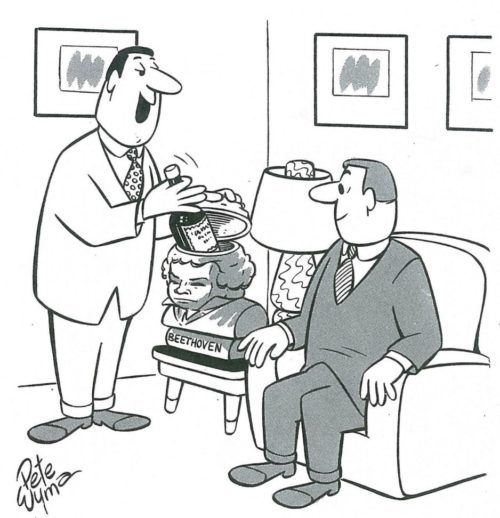
April 18, 1959
Our Post cartoonists know that being the perfect host isn’t always easy.
Just What the Doctor Ordered
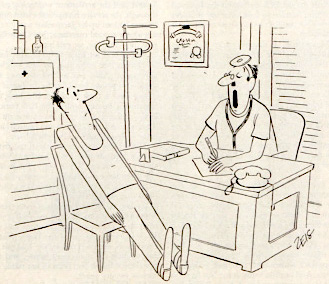
Joe Zeis
January 07, 1956
A cartoon a day just might keep the doctor away!
Snow Woes

November 01, 2002
The snow definitely looks pretty, but when it leads to hours of shoveling or a terrible tumble, it’s not so lovely anymore. These cartoons laugh at the indignities of winter.
Animal Antics
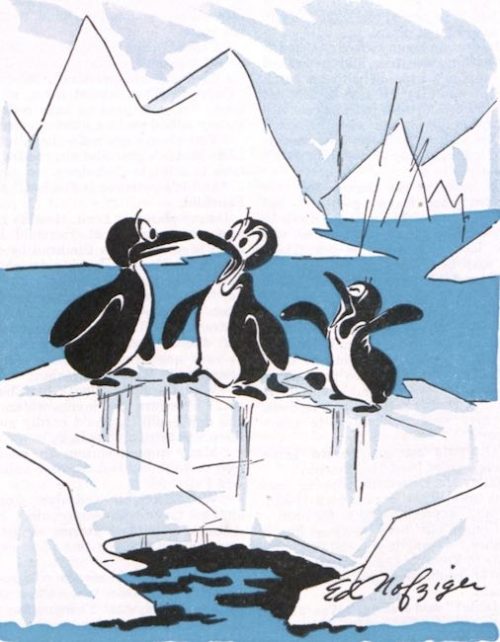
Ed Nofziger
December 21, 1940
These animal cartoons are so doggone funny, you won’t be able to bear it — in fact, you’ll go ape!
Heaven Help Us!
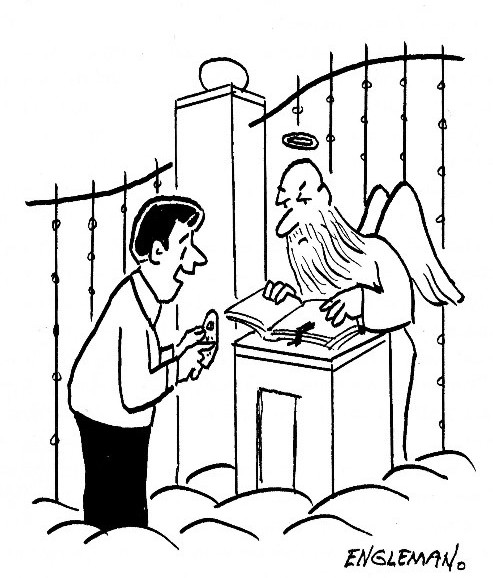
March 1, 2009
You’ll love these scenes from the Pearly Gates.
Cartoons from 1925

Nate Collier
June 13, 1925
Much has changed since 1925, but has our sense of humor? Take a look at these cartoons from 1925, and you be the judge.
A Dog’s Life
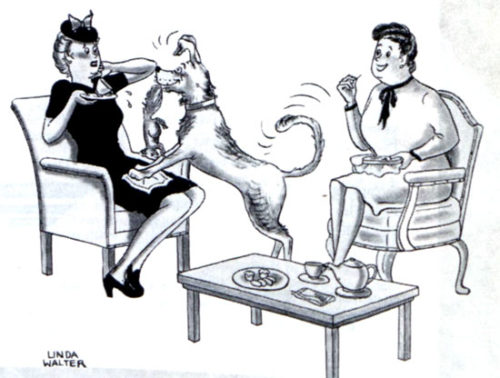
Linda Walter
December 18, 1943
These doggone funny cartoons will have you rolling over and begging for more!
Digital Daffiness

Tim Lachowski
March 1, 2010
Whether you love your smartphone or loathe it, you’ll find something to make you chuckle in these cartoons of digital wit.
Comical Commutes
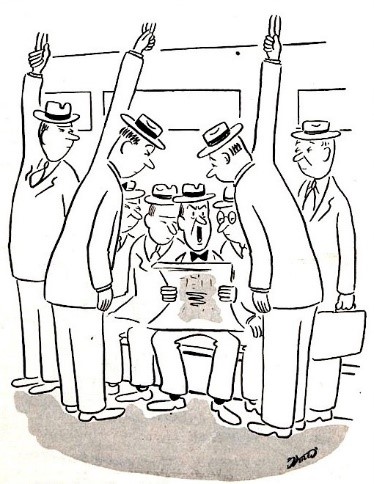
December 1, 1951
Whether by car, train or bus, these commuters might take issue with the sentiment, “It’s not the destination; it’s the journey.”
Con Watch: Use Caution with Cryptocurrencies Like Bitcoin

Steve Weisman is a lawyer, college professor, author and one of the country’s leading experts in cybersecurity, identity theft, and scams. See Steve’s other Con Watch articles.
With the incredible rise in value in the last year of bitcoin and other cryptocurrencies, many people are asking themselves if cryptocurrencies are legitimate and, if so, if they should be investing in them.
A significant number of investment gurus, such as the legendary Warren Buffett, believe cryptocurrencies are not a good investment but, rather, are a bubble that will burst, leaving unwary investors with tremendous losses. However, many other investors see increasing value in cryptocurrencies. As with any investment, be sure to follow the primary rule: Never invest in anything unless you understand what you’re investing in.
What Is Cryptocurrency?
Cryptocurrencies first appeared in 2009 on the heels of the international financial meltdown. Bitcoin was one of the first to be developed, but there are more than a thousand others. Cryptocurrencies are entirely digital in nature; there are no physical tokens. As the “crypto” part of their name suggests, they use cryptography for security. Cryptocurrencies are not issued or regulated by any government authority.
Hacking Threats
Digital currencies such as bitcoin carry the same inherent vulnerabilities of anything digital and are susceptible to being hacked. On August 2, 2016, $78 million worth of bitcoins were stolen through a data breach at the popular Hong Kong bitcoin exchange Bitfinex, which resulted in a 20 percent drop in the value of bitcoin. In the last year, there have been increasing attacks on cryptocurrency exchanges by hackers from North Korea.
Hackers have a number of different methods for stealing cryptocurrencies: They take over the accounts of unsuspecting cryptocurrency owners who fail to change their initial default login credentials. They establish malicious trading sites and lure in unsuspecting cryptocurrency investors. Or they use a specific type of malware called CryptoShuffler. CryptoShuffler works with numerous types of cryptocurrency, including bitcoin, Ethereum, Zcash, Monero, and Dash. When downloaded onto your cellphone or computer, most often through clicking a link in an infected “spear phishing” email, it will wait to see when you are paying for something with a cryptocurrency and then automatically transfer the amount to a wallet controlled by the criminal. There are security software programs that can protect you from CryptoShuffler.
Investor Threats
The highly unregulated nature of cryptocurrency has led to a number of scammers taking advantage of consumer interest. Trendon Shavers was convicted and sentenced to prison on charges of securities and wire fraud in relation to his offer to investors of 7 percent weekly interest on bitcoins deposited with his Bitcoin Savings and Trust Company. This promise of an annual percentage interest of 3,641 percent managed to lure investors to turn over 740,000 bitcoins, valued at the time at $4.5 million. Shavers advertised his scheme on the internet bulletin board “Bitcoin Forum” and other online discussion groups. He claimed that by using his market-arbitrage strategy, which included lending and trading bitcoins online, he could achieve these incredible returns. Shavers’ Ponzi scheme initially appeared to be legitimate by paying profits to early investors. However, as with Ponzi himself, there were no profits, and the early investors were paid with the funds provided by newer investors to make the phony investment scheme appear legitimate.
With cryptocurrency receiving increased consumer attention, Initial Coin Offerings (ICOs) are particularly attractive to people who think that any cryptocurrency involves huge investment payoffs. What many investors fail to understand is that an ICO is merely the issuing of virtual tokens by companies raising capital without having to register the investments with the Securities and Exchange Commission (SEC). While in some instances, these ICOs do not need to be registered with the SEC, in other cases, the SEC is bringing legal action against the companies, arguing that the ICOs are not exempt from securities regulation laws.
SEC Chairman Jay Clayton cautioned investors about ICOs, saying, “if a promoter guarantees returns, if an opportunity sounds too good to be true, or if you are pressured to act quickly, please exercise extreme caution and be aware of the risk that your investment may be lost.”
Protecting Your Cryptocurrency
If you do decide to invest in bitcoin or any other cryptocurrency, it’s important to take the steps necessary to store it securely because cryptocurrencies will always be a prime target for hackers.
- Use a strong password that is unique to your cryptocurrency account. Do not use the same password that you use for other accounts that may end up in the hands of hackers due to data breaches elsewhere.
- Use dual-factor authentication so that even if your password is compromised, your cryptocurrency tokens will not be in danger.
- Encrypt your software wallet and back up your entire wallet on a physical device, such as a portable USB drive that is not connected to the internet. You may even wish to use a hardware wallet that stores your private keys in a secure hardware device that is not susceptible to viruses and malware that can attack your software wallet.
- Update your bitcoin or other cryptocurrency software as soon as the latest security patches become available.
Festive and Fun Holiday Cocktails and Appetizers
With the New Year right around the corner and everyone’s minds focused on their waist-trimming resolutions, we’ve compiled a list of festive, fun cocktails and appetizers for your New Year’s Eve party that won’t add another notch to your belt.
Oven Baked Zucchini Chips
Oven baked zucchini chips will keep your carb cravings at bay. With nutty parmesan and a mix of seasonings, these light and airy “chips” are portable and easy to eat with a cocktail in hand.

Skinny Buffalo Chicken Dip
This skinny buffalo chicken dip will be the star of your party. By making simple changes, like using Greek yogurt instead of sour cream, you’ll retain the flavor but lose the calories. Pair it with veggies instead of crackers or chips and you’ve got a low-calorie treat that tastes every bit as decadent as you would hope.
Greek Layer Dip
The classic Mediterranean flavors in this dip will complement any holiday party. Using heart-healthy hummus and olives, fresh vegetables like tomatoes and cucumber, and low-fat feta, no one will be wishing for a high-calorie version. Adding fresh herbs like parsley and dill will send this dip over the edge. Serve with sliced veggies or toasted pita bread.

Cranberry Ginger Spice Sparkling Holiday Cocktail
Cranberries are a must-have on any holiday table, but cranberry juice is filled with sugar and can overload your cocktail with sweetness. This Cranberry Ginger Spice Sparkling Holiday Cocktail will give you the tart cranberry flavor without too much added sugar. The classic combination of rosemary and cranberries will be sure to put some excitement in your holiday party.

Blueberry Mint Fizz
Blueberries may make you think of summer, but combining them with mint and club soda turns them into a festive fruit cocktail for the season. Agave syrup to taste lets you control how the calories in your cocktail, and with the sweet and light flavors of the mint and blueberries, you most likely won’t be reaching for it.
Peppermint Mocha White Russian
It’s hard to think of a flavor more festive to the season than peppermint. Peppermint cocktails tend to be both full of fat and sugar, but this toned down Peppermint Mocha White Russian has some easy swaps (Cool Whip for whipped cream) that leave you with all the flavor and none of the guilt.

Cover Collection: The Circus Is in Town!
Trapeze artists, clowns, elephants… the exotic magic of the circus has long been a part of the American tradition. These colorful Saturday Evening Post illustrations capture the spirit of the Big Top.
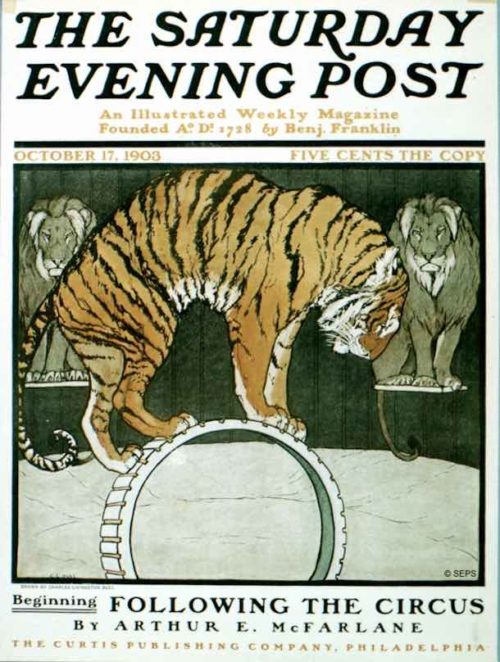
Charles Bull
October 17, 1903
Charles Bull painted dozens of covers featuring animals — cows and cats, owls and eagles, deer and dogs — for The Saturday Evening Post and its sister publication, Country Gentleman. This was his only cover showing animals at the circus.
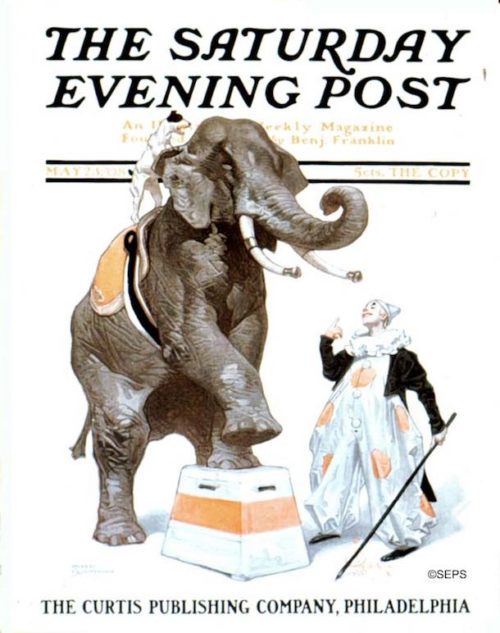
J.C. Leyendecker
May 23, 1908
Leyendecker painted six circus-themed covers for the Post, most of which featured the majestic elephant. That little black and white dog must have been Leyendecker’s muse, appearing on at least 16 of his Post covers.
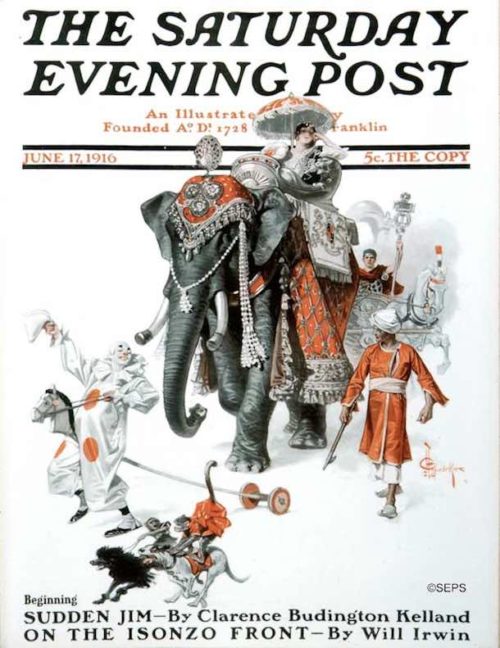
J.C. Leyendecker
June 17, 1916
Our art critic, David Apatoff, notes that the original paintings that were reproduced on the cover of the Post were far larger than the magazine — sometimes four or five times larger. And they were painted with oil paint on canvas, just like fine art in the greatest museums. Often, Post cover artists had been trained in a classical fine art tradition. Leyendecker, for example, trained in Paris at the Académie Julian. For more on this particular painting, read Apatoff’s article, The Hidden Talent of Post Cover Artists.
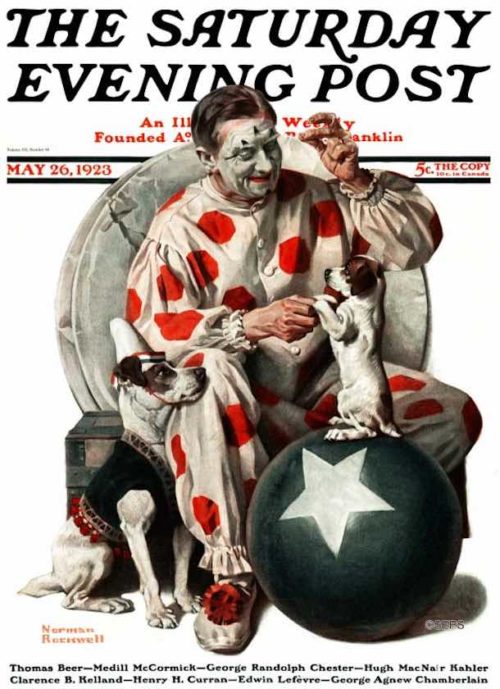
Norman Rockwell
May 26, 1923
A look behind the scenes at the big top reveals the house of disciplined practice that result in a show that delights the circus-goers in the ring. The pup learns his lesson under the stern eye of the older dog, who manages a degree of dignity despite the absurdity of the costume.
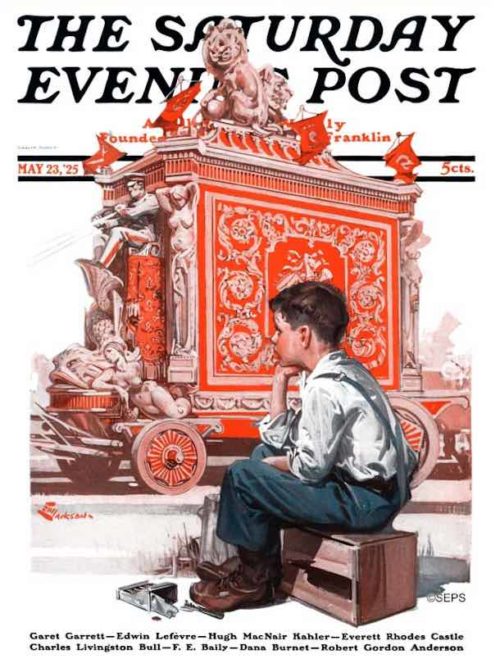
E.M. Jackson
May 23, 1925
These music-making “steam pianos” were often seen on riverboats and in circuses. Most had 32 whistles. The sound will be forever associated with the circus.
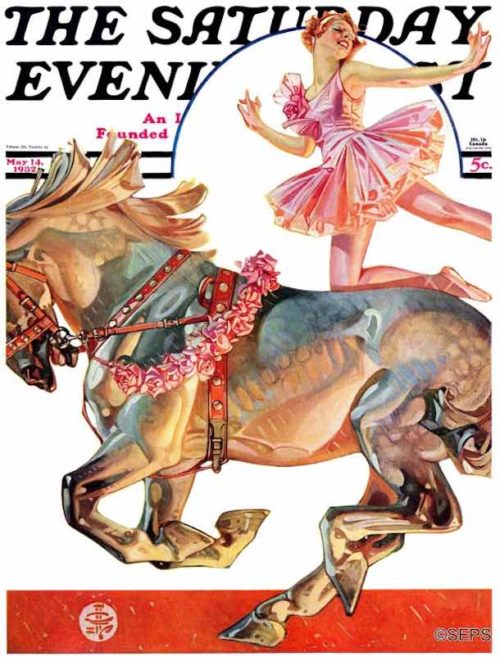
J.C. Leyendecker
May 14, 1932
Leyendecker masterfully captures the tension between the muscular strength of the horse and the delicate balancing act of the rider. The horse reflects the astonishing colors of the circus around him.
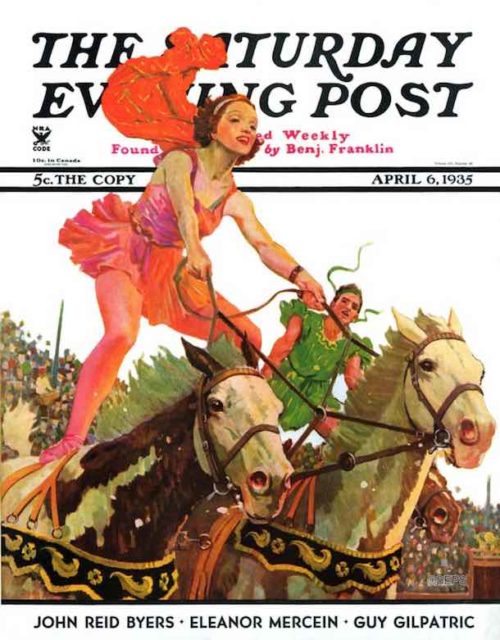
Maurice Bower
April 6, 1935
Maurice Bower offers another view of circus horses and riders. Horses were a favorite subject of Bower’s; he painted numerous covers featuring them pulling stagecoaches, sulkies, and firetrucks.
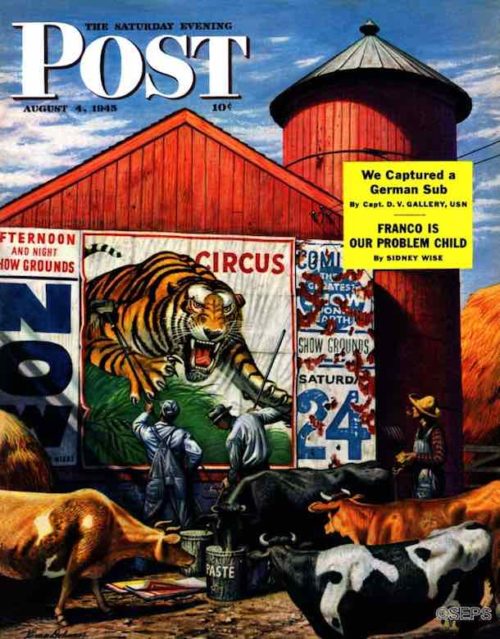
Stevan Dohanos
August 4, 1945
Stevan Dohanos showed that circuses meant palate-tickling excitement to cows too. Poster paste — a succulent mixture of flour and water, and copper sulphate to keep it from souring — seems to be the bovine equivalent of a dry martini. The two Ringling Brothers Barnum and Bailey bill posters, Bill Feigley and Bob Aikens, who consented to pose for Dohanos, kept a wary eye on horned kibitzers while covering previous circus posters with their own particular brand.
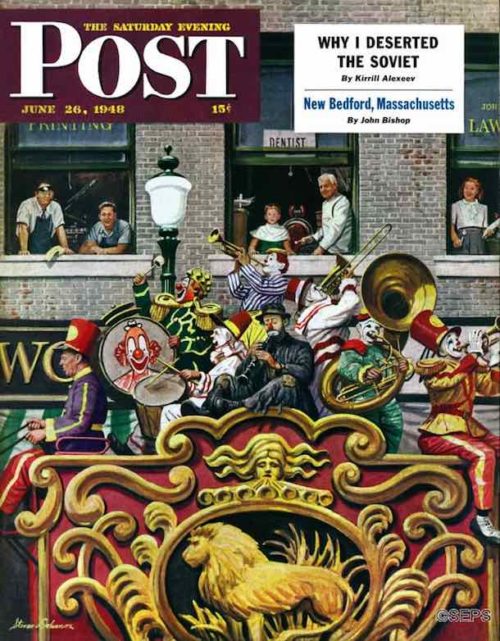
Stevan Dohanos
June 26, 1948
Stevan Dohanos painted the big parade down Main Street, once a standard feature of that great summer day, The Day the Circus Came to Town. “Circuses don’t parade much anymore,” said the artist in 1948, “but I think it’s a grand old custom and I wish I could help restore it.” The clowns were members of the famous Ringling Brothers-Barnum and Bailey team, with the sad-faced Emmett Kelly pretending to play the clarinet. The clowns posed for Dohanos in the back lot behind Madison Square Garden, between performances in New York.
Most Popular Saturday Evening Post Articles of 2017
As 2017 draws to a close, we share our most popular articles that were published this year.
1. 7 Reasons to Hang on to Your Landline Phone

Thinking of ditching your landline? Make sure you understand the pros and cons first.
2. 10 Most Bizarre Inauguration Facts

Do you know which president’s podium caught on fire, who gave the longest inaugural address, or who first wore long pants to his inauguration? Find out with these inauguration facts!
3. Coping with Estranged Adult Children

At what point do our adult children cease to be the adoring babies we once knew? One writer shares her very personal story. ‘
4. 8 Most Embarrassing Presidential Family Members

Which president had the most embarrassing relative? From drunkards to doofuses, here is our list of the 8 worst offenders.
5. The Average American Today and on the Eve of World War I
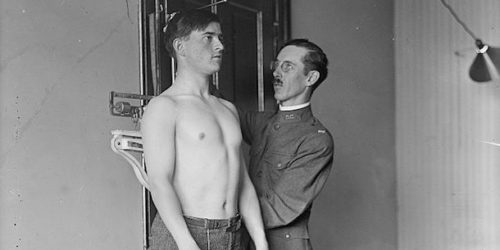
What it means to be an “average American” today is in many ways so different from what it meant a century ago, when the United States entered World War I.’
6. 8 Most Embarrassing Presidential Gaffes
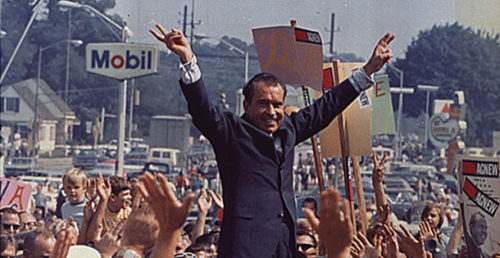
Gaffes, for any president, seem to be inevitable. Below is a list of the eight most regrettable moments from the highest office.’
7. The Nude Look Takes Over: 50 Years Ago
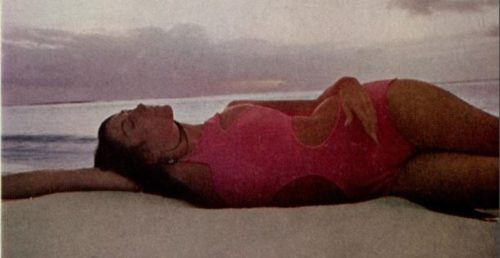
Fifty years ago, the Post featured bathing suits with low backs and cut-outs that were considered slightly scandalous. Even some modern readers decided this 50-year-old article was too much for them!’
8. The Art of the Post: The Rockwell Cover that Led to a Marriage

David Apatoff shares the story of the time Norman Rockwell inadvertently played matchmaker for a neighbor’s daughter.’
9. 11 Facts about Presidents and Approval Ratings

Which president was the most popular? Whose approvals fell most dramatically? Our 11 facts about presidential approvals show you the most loved and loathed.’
10. You’re Probably Alive Because of a Moldy Cantaloupe from Peoria
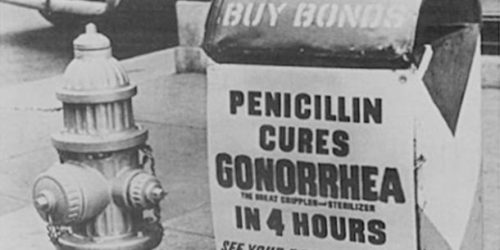
Scientists struggled to mass-produce penicillin until two doctors found the perfect moldy cantaloupe at a market in Illinois.’
North Country Girl: Chapter 32 — Bamboozled at East High
For more about Gay Haubner’s life in the North Country, read the other chapters in her serialized memoir. The Post will publish a new segment each week.
As if we were still in elementary school, we teenagers delighted in anything that was a disruption in the school day. One poor kid, not the brightest light in the harbor, made a series of phone calls to the East office, claiming he had placed a bomb in the school, freeing the rest of us outdoors into the grey chill of a Duluth spring, no time to fetch coats or mittens from our lockers. Standing where somebody decided was a safe enough distance from a bomb, we kept warm by huddling in our little cliques, reveling over being sprung from chemistry or French II or metal shop.
Since the fake-bomb-threat miscreant had been spotted at the school’s one and only pay phone immediately before each evacuation, we all knew who he was, but our lips were sealed. The last time he called in a bomb threat, he must have been unhinged by the many thumbs up shot his way by passing students; he stuttered out to the school secretary, “And this isn’t (miscreant’s name)!” We never saw him after that.
Assemblies also broke up the school day; unlike the thunderous pep rallies held in the acoustically challenged gym, during assemblies you could have a whispered gossip or flirtation with the person next to you or even go to sleep.
One morning the crackly voice of Mr. Srdar, the principal, came over the ancient mesh loudspeakers mounted in every classroom. “Attention students: There will be a special assembly at ten o’clock tomorrow. All students are required to attend.” Rumors flew: was a friendly policeman in uniform coming to talk to us about drugs? Did they finally figure out which teacher was sleeping with his students? The worst scenario was yet another visit from Junior Achievement, touting the virtues of capitalism and on the prowl for future Titans of Industry. If that were the case, at least we could all catch an hour nap.

The next day we trooped into East’s auditorium and reverted to rowdy eight-year-olds; the big room rang with shouts, laughter, and whistles. The principal shushed us down into a quiet roar, and we jostled for seats, seats whose wooden bottoms had been worn so slick and shiny by generations of teenage bottoms that if you slumped or fell asleep you were in danger of sliding to the floor.
Mr. Srdar stood at the podium someone had thoughtfully placed on the left side, where it caught the watery spring light. He introduced the day’s special guest, who would speak to us about the famine in Africa.
This was unexpected and shut us up. We looked from side to side, acknowledging that every single one of us, even kids who couldn’t find the world’s second largest continent on a globe, had been implored to “Think of the starving children in Africa” when staring down a plate of grey meatloaf, calf’s’ liver, or boiled-to-death broccoli, which was supposed to make the disgusting mess more appetizing.
An earnest young man in khakis stepped up to the podium, introduced himself, and spoke about the war in Biafra, waving around a copy of National Geographic. He described the starving children he had seen, their stomachs bloated, their eyes dull. He said when the children’s hair turned red it was a sign that they were dying. Their bodies were not taking in enough nutrients to create the dark hair pigment: a little red-haired African child was a walking corpse.
He was good, so good that no one questioned why he had no photos, only a copy of a magazine, or why, if he was just back from Africa, he was as pale as any Minnesotan in March.
When he made a little choking noise in his throat, and dropped his head, girls all around me started to weep, searching in their bags for Kleenex to blot their tears and blow their noses. Even a few of the boys were squirming and blinking. This went on for a while, the young man droning on with his dramatic descriptions of dying kids and keening mothers. I wondered what the hell is going on here?
Then came the pitch. This nice young man was raising money for the starving children of Africa (no, we still couldn’t just send them our spinach and fish sticks) through a brand new kind of fund-raiser: a Walk-A-Thon, a 20-mile trek through Duluth. To participate, we had to ask our parents, parents’ friends, aunts, uncles, grandparents, any available adult with money in pocket, to sponsor us at so much a mile — preferably a dollar.
He said, “Imagine you’re holding a little African in your arms. Imagine that baby’s scrawny limbs, the distended belly barely covered in rags, the head that seems too large topped with a scruff of tightly curled, rust-colored hair. That baby is looking at you with big brown eyes, pleading for help. If you do not participate in the Save Africa Walk-a-Thon, you are dumping this poor dying baby out of your lap and letting that baby die.“
Even the football players were sniffing now, and some girls were red-faced from bawling. Mr. Srdar dabbed his own wet eyes with a big white hankie, congratulated the young man on the noble work he was doing, and assured him that he could count on East High students.
The Walk-A-Thon was scheduled for that Saturday. We were told the meeting place and instructed to bring our sponsors’ money with us. We were not given sign-up sheets, collection envelopes, buttons, pamphlets, or t-shirts. None of us thought this was odd as we went about pestering parents, family friends, and relatives for money.
I knew better than to ask my own mom, certain what her response would be to giving away money to perfect strangers. My dad and one set of grandparents were Missing In Action, the other grandparents hundreds of miles away. I walked over to Lakeview Avenue, my old block, and knocked on the McCauleys’ door; they were an older couple who were always good for a couple of boxes of Thin Mints or Samoa Girl Scout cookies. I was not nearly as eloquent as the young man and had a hard time explaining why Mrs. McCauley should give me the immense sum of twenty dollars so I could go on a walk. She pulled a crumpled one from a change purse, I took it, thanked her, and headed over to Michael Vlasdic’s house.
Michael was not walking. He had no interest in any extracurricular activities besides listening to records, taking drugs, and screwing me. Always a good sport, Mrs. Vlasdic gave me a twenty and told me I was a gutes Maedchen.
On a bright spring morning, a sympathetic mother delivered me and a passel of my friends to the Walk-a-Thon starting point, where the young man stood with a clipboard, writing down kids’ names, taking their money, handing out blurry mimeographed maps, and thanking us for saving all those babies’ lives.
We were somewhere in West Duluth, a neighborhood I hadn’t been in for years, and then only to visit the small and smelly Duluth Zoo, where an irate, aggressive and way too close squirrel monkey had once tried to snatch my mom’s beehive hairdo off her head. As I squinted at the blurry map, trying to make sense out of all the random rights and lefts, the young man blew a whistle and we headed off en masse.

The first five miles weren’t so bad, we were with our friends, we were outside in the fresh sun of spring, joking and laughing, and extremely proud of ourselves. We were the better angels, the generation that was going to save the world. The next month, on April 22, a bunch of us do-gooders would be down on Park Point beach, celebrating the first Earth Day, saving the planet by creating rickety sculptures of driftwood while tripping on LSD.
By mile 10, there was no more laughter, only silent plodding. We wore flimsy sneakers and carried nothing; running shoes, bottled water, and energy bars had yet to be invented. I don’t know if anyone made it past the fifteen-mile mark. At that point I hobbled home, fell on the couch, and gingerly took off my Keds and ankle socks to reveal swollen, throbbing, blister-covered feet, while my mom yelled at me for being gone all day without calling.
What hurt even worse was finding out that our nice young man was not saving babies, but lining his own pockets. Too late Mr. Srdar got a phone call from a high school in St. Cloud, telling him to be on the lookout for a traveling flimflam man, who like Professor Harold Hill in The Music Man, went from one innocent small town to the next, selling us nothing, not even big trombones or ratatat drums.
Even though I had watched Michael Vlasdic tear up during that hornswoggle of a speech, now he was miffed that I had given away his mom’s twenty dollars, which would have bought four hits of acid.
Since my father had left, my own cash flow had trickled down to nothing. My mom did not have a bank account in her name. It took several phone calls and several weeks before my dad would reluctantly show up to place some actual cash in my mom’s hand. She would then, almost as reluctantly, peel off a few bills for me. From that pittance I had to pay for my share of gas and booze on Friday nights with my pals, and for the drugs Michael and I took on Saturday.
But suddenly it was summer, school was out, and I was sixteen, old enough to find a job. The Flamette, a diner that was swarmed with tourists in the summer, hired high school girls. My friends Nancy, Betsy, and Debbie waitressed there, I looked on, jaw agape, as they competitively counted up their tips after work. I filled out a Flamette application, leaving the “Experience” section blank, and was shown the door.
I next applied to be an A&W carhop; the manager took one look at my scrawny arms and knew that I would immediately dump a tray laden with those heavy glass mugs of root beer and ice cream over myself or a customer.
I lowered my sights to restaurant kitchen work. When we were still a family, my father had spent enough money at the Bellows Steak House that the manager recognized me as I sat in the waiting area on a June afternoon, clutching my application form. He hired me as a salad girl. I would work four nights a week and make $1.90 an hour.
My work night started at four o’clock. My primary duty was preparing the mix for the big salad that came with every dinner and that was ninety percent iceberg lettuce. In the basement prep kitchen I’d give each head of lettuce a good thunk on the bottom and twist out the core as instructed by the scary chef. He had also shown me how to operate the electric lettuce shredder without losing a finger, but I was too terrified of that whirling, deadly contraption to put a hand anywhere near it. Instead I stood across the room and tossed heads of lettuce towards the blades, again and again, gathering the bits that went all over the floor and adding them to the giant plastic salad bin.
I assembled salad after salad so that they could be delivered, cold and crisp, to diners who would smother them with French, Thousand Island, or Roquefort. It was my job to keep the tripart salad dressing servers filled; I never washed those servers, just gave them a quick wipe with a kitchen rag to clean off the crust along the sides of the silvery cups and the top of the ladles.
My other task was making shrimp cocktails, and boy, Duluthians loved their shrimp cocktails. After the eight hundred salads were made and chilling, I pulled a huge bag of shrimp out of the freezer and dunked it in a sink filled with lukewarm water. I spent the next hour peeling and deveining shrimp, stopping to pull out salads for early bird diners and hoping that they wouldn’t order the shrimp cocktail as basically they would get shrimp-flavored ice cubes.
The nadir of my night was when some brave or deluded soul ordered a platter of oysters or clams on the half shell. While unordered shrimp ended up in the next night’s scampi, the restaurant had no use for leftover bivalves, so I could not defrost them in advance. I had to struggle with each frozen shell, holding it under running water, attacking it with an oyster knife, and cutting my own hands to pieces. Then I had to slice a lemon.
Finally, towards the end of the night, with a few hateful customers lingering in the dining room trying to decide if they should have one more Grasshopper or Golden Cadillac or Brandy Alexander, the kitchen would quiet and slow. The cooks scraped black squares of pumice up and down the grill while the waitresses snuck back to my little area to grab a forbidden smoke. I was in awe of these creatures, with their elaborate updos, kabuki eyebrows and eyeliner, and pockets bursting with ones. They paid me no attention at all, I was a mere salad girl, covered in shreds of lettuce and smelling of shrimp.
Every week I cashed my paycheck at the Bellow’s and immediately set out to buy drugs, a task that pathologically shy Michael Vlasdic had relegated to me. Even with my onerous work schedule, the freedom of summer meant that Michael and I could trip several times a week. There were kids from East High who could be counted on to have acid, my old admirer Stan now one of them. I could call John Bean; although I was always afraid that he would bring along Doug Figge, he never did. If no one I knew had LSD, I took the bus downtown to the scary, sinister pool hall, where the greasers from Central and Denfeld High hung out, a place that was so forbidden to a nice East High girl that it went unmentioned.
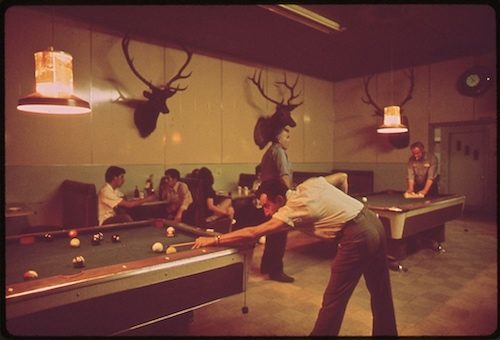
Fortunately, I never had to actually go into that dimly lit den of perdition. I’d poke my head in the doorway, and some long-haired guy in a white tee would nod, follow me out, and lead me to the back alley.
I hated buying drugs at the pool hall, convinced that I was going to be raped, robbed, and murdered by one of the dodgy seventeen-or eighteen-year-old dealers. I pleaded with Michael, “I’ll give you the money, but please, can you go make the buy?” Michael blanched at the idea of talking to a stranger, even one who sold drugs; but I was tired of risking my life. He reluctantly took my money and I felt like the worst girlfriend in the world.
That evening I let myself into the Vlasdic’s house. Michael was lying on the living room floor, staring at the ceiling. I shook him, “Michael. You bought acid right?” He nodded. “Ah, can I have mine?” He shook his head, pointed at his open mouth, and closed his eyes. I disgustedly left him there to trip on his own, went back home straight as a stone, and kept control of the money and the drugs from then on.
Most Popular Cover Collections of 2017
1. Salute to the 50 States

Sailboats
John Clymer
November 28, 1959
From the lighthouses of Maine to the majestic Cascades of Oregon, The Saturday Evening Post has represented every state on its cover. Here are 50 of our favorites. (Apparently they were your favorites, too!)
2. Back to School
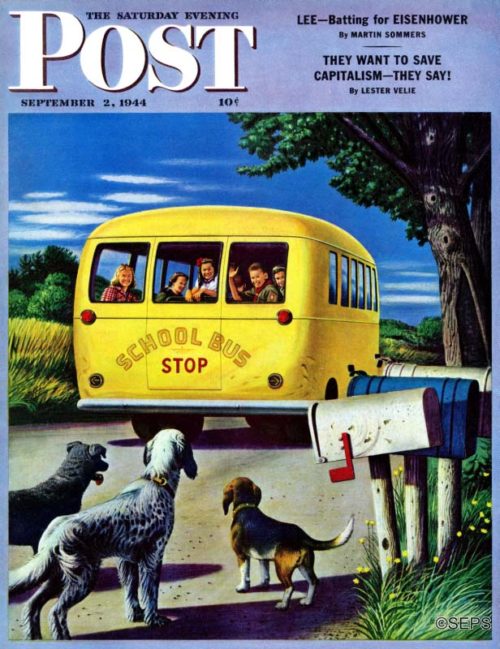
Stevan Dohanos
September 2, 1944
Classrooms may have changed from pencils to PowerPoint, but our magazine has always been there to witness sending our kids back to school.
3. Tee Time
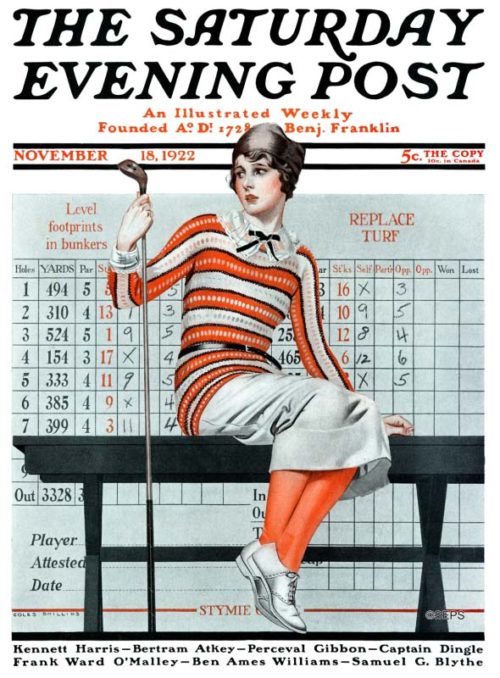
Coles Phillips
November 11, 1922
These covers show that golf is much more than a good walk spoiled. (It s a good day spoiled.)
4. Fall Video Gallery: Vintage Baseball Covers
Artist John Falter brought the fall season to life through his many covers for The Saturday Evening Post. This video highlights some of our favorites.
5. The Best Santas Ever
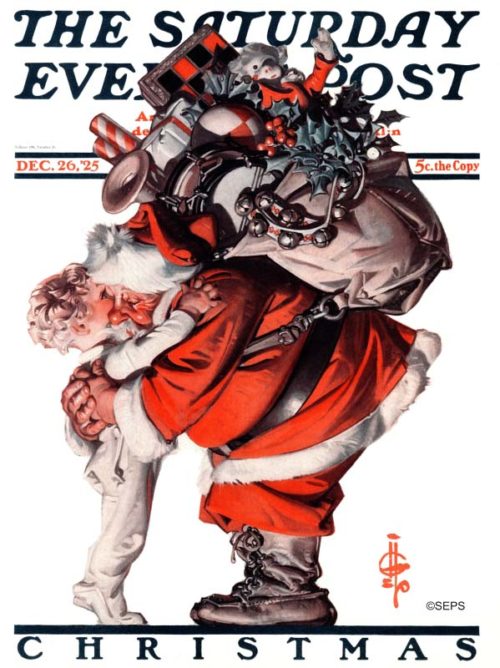
J. C. Leyendecker
December 26, 1925
Over the decades, we’ve featured iconic images of Santa Claus on our December covers. Famed illustrators Norman Rockwell and J.C. Leyendecker created some of the most cherished depictions of St. Nick.
6. Time for Pie
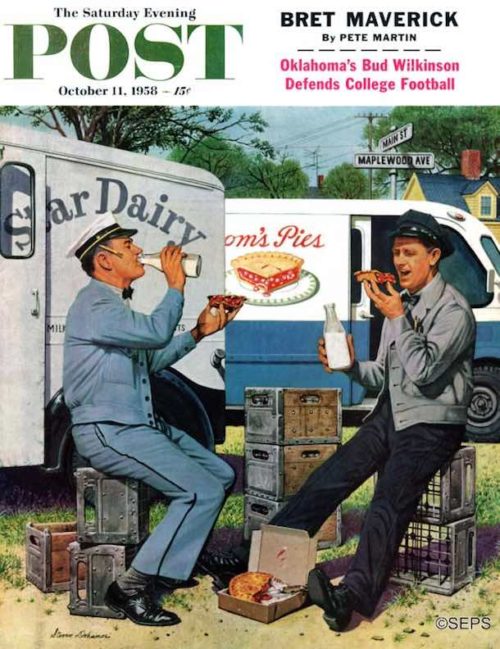
Stevan Dohanos
October 11, 1958
Pie follows closely on the heels of turkey as the quintessential Thanksgiving dish. These pies plus recipes will inspire your pursuit of pastry.
7. Presidents
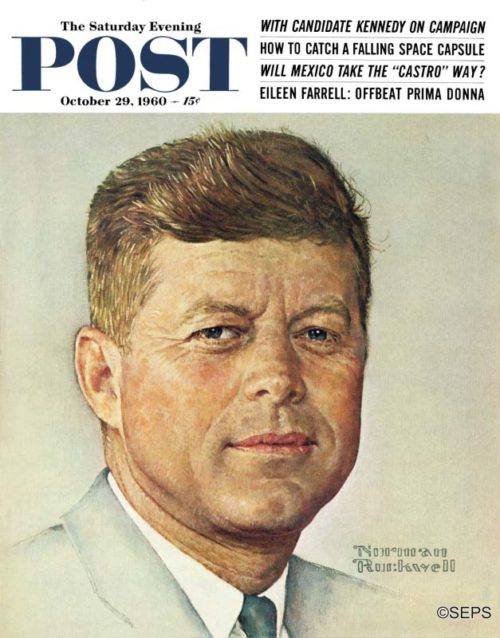
By Norman Rockwell
October 29, 1960
From Grover Cleveland to Richard Nixon, The Saturday Evening Post featured many U.S. presidents on its covers in its nearly 200-year history.
8. Celebrating America

John Falter
July 5, 1952
With fluttering flags and steadfast soliders, the Post has honored the land of the free and the home of the brave.
9. Travel Nightmares
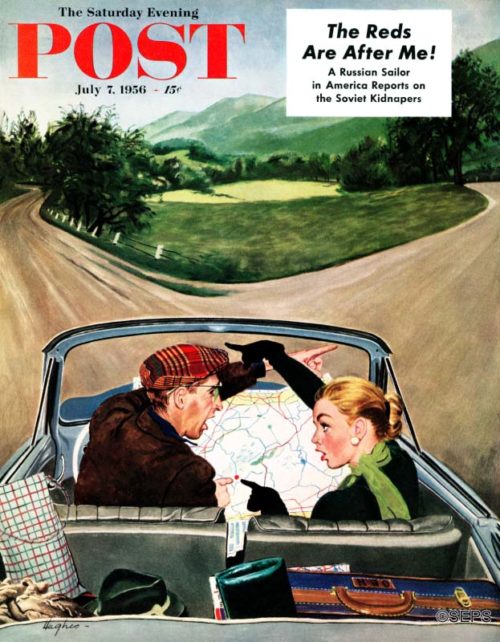
George Hughes
July 7, 1956
These illustrations of jaunts gone wrong might make you re-think that summer road trip.
10. Congrats, Graduates!
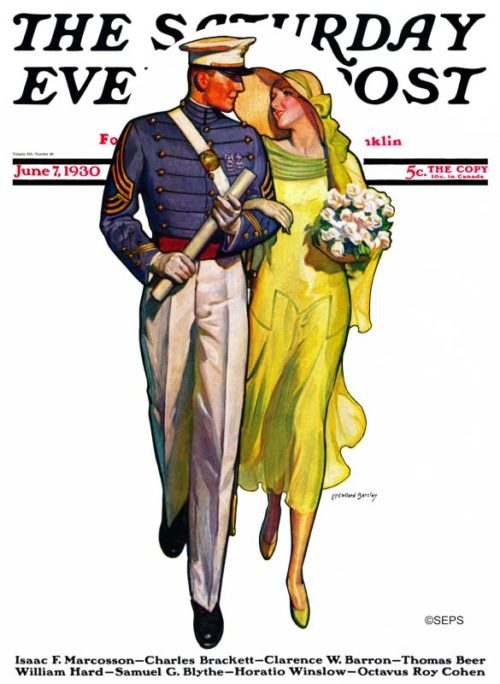
McClelland Barclay
June 7, 1930
This moment of accomplishment has made frequent appearances on our covers, starting more than a hundred years ago.
Your Weekly Checkup: High Blood Pressure — The Silent Killer
We are pleased to bring you Your Weekly Checkup, a regular online column by Dr. Douglas Zipes, an internationally acclaimed cardiologist, professor, author, inventor, and authority on pacing and electrophysiology. Dr. Zipes is also a contributor to The Saturday Evening Post print magazine. Subscribe to receive thoughtful articles, new fiction, health and wellness advice, and gems from our archive.
My blood pressure (BP) has kept pace with my age, slowly creeping up despite a healthy life style. Aging blood vessels become less pliant and cause BP to rise in older people. Psychosocial stress can also play a role. Recent estimates indicate that almost 900 million adults worldwide have a systolic BP of 140 mm Hg or higher, with 80% of people older than 75 years being hypertensive.
It s not by accident that hypertension, one of the leading causes of heart disease and stroke, is called the silent killer. In its early stages, an elevated BP produces no symptoms even as the constant pounding begins to take its toll on kidneys, heart, brain and other organs. Symptoms appear when these organs show the effects of wear and tear: kidney failure, heart attacks, heart failure, and strokes. Fortunately, my astute physician spotted the BP rise early and instituted appropriate treatment. Older patients benefit most from controlled BP, experiencing reduced cardiovascular and kidney disease, strokes, and mortality.
What is a normal blood pressure? Experts have recently reevaluated hypertensive guidelines, defining the various BP stages as follows:
- Normal: Less than 120 systolic/80 diastolic mm Hg
- Elevated: Systolic 120-129 and diastolic less than 80 mm Hg
- Stage 1 hypertension: Systolic 130-139 or diastolic 80-89 mm Hg
- Stage 2 hypertension: Systolic at least 140 or diastolic at least 90 mm Hg
- Hypertensive crisis: Systolic over 180 and/or diastolic over 120 mm Hg, with patients needing prompt changes in medication if there are no other indications of problems, or immediate hospitalization if there are signs of organ damage.
Who should be treated and with what? Initially, lifestyle modifications including the DASH diet (Dietary Approaches to Stop Hypertension: reducing salt and processed foods; eating potassium-rich fruits and vegetables, whole grains, low-fat dairy foods, and lean sources of protein), exercise, weight loss, moderate alcohol consumption, and stopping smoking should be adopted by everyone.
Medications are recommended for Stage I hypertension if a patient has already had a cardiovascular event such as a heart attack or stroke, or is at high risk of heart attack or stroke based on age, the presence of diabetes mellitus, chronic kidney disease or calculation of atherosclerotic risk.
The biggest risks of intensive BP therapy are dizziness on standing in frail elderly patients and acute kidney injury in patients with long-standing diabetes and kidney disease. Because coronary heart disease (atherosclerosis) goes hand-in-hand with hypertension, statin therapy is indicated for many patients with hypertension. Medication non-adherence is a major cause of apparent drug-resistant hypertension and adverse cardiovascular outcomes.
There are lots of things in life beyond our control that can influence our health: genes, sex, and age, for example. However, regulating BP is one risk factor we can control to reduce many adverse outcomes, particularly as we grow older. Check with your doctor. Monitor your BP. You ll be glad you did.
September/October 2017 Limerick Laughs Winner and Runners-Up
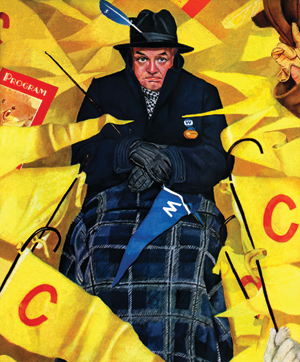
This highly unorthodox fellow
Sports blue in an ocean of yellow.
He is only on hand
Since his son’s in the band.
(It’s a brass band, and he’s playing cello.)
Congratulations to Jeff Foster of San Francisco, California! For his limerick, Jeff wins $25 and our gratitude for his witty and entertaining poem describing Sitting on the Wrong Side, Gene Pelham’s cover from November 15, 1941.
If you’d like to enter the Limerick Laughs Contest for our next issue of The Saturday Evening Post, submit your limerick through our online entry form.
Our readers sent us a lot of great, funny limericks. Here are some more of our favorites, in no particular order:
A faithful fan of West U.,
Among fans of the opposite crew,
With muffs on his ears
To drown out their cheers —
What else could the poor guy do?—Howard D. Dashke, Caseyville, Illinois
This fan’s in a heck of a fix,
Forlorn as his team takes its licks.
Surrounded by yellow,
This unhappy fellow
Would do well to just hit the bricks.—Bruce Beardsley, Rochester, New York
The loneliest man in the stands
Is not the one stuck behind bands.
He’s the visiting fan
With no escape plan
While the home team’s lead slowly expands.—Jerry Dorbin, Santa Fe, New Mexico
Our fan though his ticket was true.
He came with a banner in blue.
What he found out instead
Made his face turn bright red:
The flags had a much diff’rent hue.—Dick Swain, Champaign, Illinois
Oh I wonder just what I can do.
The score is now 20 to 2.
I’m such a sad fellow,
Surrounded by yellow,
While my flag and I are so blue!—Angie Gyetvai, Oldcastle, Ontario, Canada
There is little more greatly resented
Than a fan who has bravely dissented
And refuses to bend
As he proudly defends
The team he has long represented.—Mark Stellinga, Tiffin, Iowa
The look on his face held the clue
To a day he’d prefer to redo:
“What’s most upsetting,
Of course, is the betting
Of all of my money on blue.”—Paul Desjardins, West Kelowna, British Columbia, Canada
As a fan watched the drubbing unfold,
He could feel disappointment take hold.
When they asked, “Happy sir?”
His remark was just “Brrr!”
For the weather and game left him cold.—Roy Skibiski, Lawndale, California
His cheeks with their rosy red glow
Aren’t flushed from the cold and the snow.
The frustrated fellow
Surrounded by yellow
Is angry and ready to blow.
—Joyce Petricheck, Finleyville, Pennsylvania
What Would You Do for a Million Dollars?
 Of the people polled, 1 percent would leave their families, 4 percent would yield citizenship, 10 percent would marry someone they didn’t love, 11 percent would permanently give up friends, 12 percent would take off their clothes in public, 13 percent would serve a year’s jail term on a framed charge, 14 percent would take the dangerous job in which they had a 1-in-10 chance of losing their life. But 21 percent would become a beggar for a year.
Of the people polled, 1 percent would leave their families, 4 percent would yield citizenship, 10 percent would marry someone they didn’t love, 11 percent would permanently give up friends, 12 percent would take off their clothes in public, 13 percent would serve a year’s jail term on a framed charge, 14 percent would take the dangerous job in which they had a 1-in-10 chance of losing their life. But 21 percent would become a beggar for a year.
—“How We Feel about Our Money” by
Max Gunter, December 30, 1967

Movies to Watch Over the Holiday Break
Film Stars Don’t Die in Liverpool (December 29)
Oscar alert for Annette Bening: She’s breathtaking as 1950s movie star Gloria Grahame. We find her in late 1970s Liverpool, seriously ill, and throwing herself into an affair with a handsome actor decades her junior (played by Jamie Bell). Bening, gloriously unafraid to show her age on screen, brings yet another indelible screen character to life.
Molly’s Game (January 5)
Writer/director Aaron Sorkin (The Social Network) packs this based-on-a-true-story script with his usual wall-to-wall one-liners, and Jessica Chastain dazzles as a former Olympic skier who went on to run L.A.’s most exclusive illegal poker game. Idris Elba ditches his British accent as Molly’s lawyer, desperately trying to get her to roll over on her high-profile clients.

The Leisure Seeker (January 19)
Helen Mirren and Donald Sutherland make a truly endearing pair in this funny and sometimes heartbreaking story of an elderly couple taking one last jaunt in their trusty old motor home. Mirren is adorable, adopting a lyrical southern drawl. Sutherland, making the most of the best role he’s had in years, charms as a brilliant professor struggling with Alzheimer’s.
Follow Bill Newcott at saturdayeveningpost.com/movies or at his website, moviesfortherestofus.com.
This article is featured in the January/February 2018 issue of The Saturday Evening Post. Subscribe to the magazine for more art, inspiring stories, fiction, humor, and features from our archives.
Our First Christmas Without Mom
My mother died this past summer, so we’re sailing into the holidays absent our commodore. For the 63 years my parents were married, my mother let my father think he was in charge, though we all knew she steered the ship of state, both deftly and demurely.
It’s an odd feeling to imagine Christmas without Mom. She did much of the holiday’s obvious work, plus a hundred other little things we’ll likely forget in the holiday rush. I fear no one will remember to buy a flannel shirt for a down-on-his-luck man in our town, and have it gift-wrapped and under the tree, awaiting his arrival on Christmas Eve. He’s spent Christmas Eve with our family for nearly 40 years, and I don’t want the ball to drop on my watch, so I’ve written in the December 12 square of our refrigerator calendar, “Buy Dale a shirt.” Mom would never forgive us if Dale had to go without a new shirt this Christmas.
When I was little, maybe five or six, my mother took me to Danner’s five-and-dime on the Danville town square and bought me a little red Christmas elf to go on the tree. A few years later, the elf fell forward onto a hot bulb and rested there, burning his face. Now he’s an elf with a bad sunburn. Even though it was mine, Mom wouldn’t let me take the elf with me when I moved from home, but last year, while taking down the tree, she handed me the elf and told me to take good care of him. I’ve since invested that handing-over with all sorts of meaning — that Mom sensed it would be her last Christmas with us and wanted to make sure the elf was not orphaned. I keep it on the bookshelf next to my desk, its red face shining forth, keeping watch by night.
Mom never wanted anything for Christmas.
“I have everything I need,” she would tell us when we asked her what she wanted. So our gifts to her were always stabs in the dark, wild guesses, graciously received, but seldom used. Crystal vases, pottery, Irish sweaters, tucked away in back closets, while the handmade gifts we gave her as children — plastic birds, woven potholders, paint-by-number pictures — enjoyed an eternal place of prominence. One Christmas, after receiving a royalty check, I bought her a new kitchen stove and she spent the next year trying to pay me for it, slipping money in my pockets when I came to visit.
When I was a kid, I would tell my mother I loved her in the way small children do, spontaneously with great enthusiasm. When I became a teenager, and prone to embarrassment, I ended that practice and didn’t resume it for several decades. Even then, almost up until she passed, I would say it in a silly voice I reserve for endearments, so as not to sound too earnest. The day before she died, Mom took my hand and said, “I love you, Philip. You’ve been a wonderful son.” And for the first time since childhood, I told her I loved her in a normal voice. I wish I hadn’t stopped telling her I loved her when I was a teenager.
I’ve lived long enough to know Hallmark’s depiction of mothers isn’t entirely accurate. Having children doesn’t miraculously instill one with compassion, wisdom, patience, and love. Wouldn’t it be wonderful if one couldn’t sire or bear a child until those qualities were present? If God ever puts me in charge of reproduction, I’m going to do something about that.
But my mother had all those virtues and more, which I didn’t appreciate as a kid, so I would ask her for other presents at Christmastime, not realizing she had already given me the loveliest gifts one person can ever give another.
Philip Gulley is a Quaker pastor and the author of 22 books. See also our feature article about Gulley and his wife in the November/December 2017 issue.











